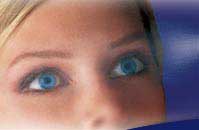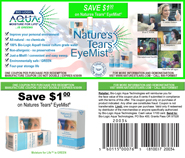
Eye Screening for Children
The AAO "InfantSEE" Program
Dry eye, eye disease and low vision in infants and children
Guest: Glenn Steele, OD (Memphis, TN), American Academy of Optometry InfantSEE program.
Dr. Glenn Steele is an optometrist representing the American Academy of Optometry's InfantSee program, and a Professor at the Southern College of Optometry in Memphis. InfantSee receives major funding from Johnson and Johnson. The program provides free vision and eye screening for children under one year old. Eight-thousand volunteer doctors in the U.S. participate in the program.
Sharon Kleyne noted that one infant in 250 is born with cataracts and there is a lack of education of parents on childhood vision and eye health and development. Some hospitals give eye exams to newborns but not all. She also noted that we begin struggling with dehydration and dry eyes from the moment of birth and it lasts throughout our lives.
Even though the need is great at all economic levels, InfantSEE focuses on the poorest people and on high risk communities (although even President Carter had two grandchildren with vision problems first detected in a school screening). The goals are to provide a free examination and screening to every child at age three months and six months, and to provide parental education about eye diseases, natural eye health and dry eye prevention.
At age three months, according to Dr. Steele, babies start to separate the senses. Before that, the senses blend together in their perception. For the separation to occur, all senses must function properly. Eyes more than anything connect the baby to the people and world around them. Eventually, eyes are able to anticipate the other senses (you can often tell by looking at something if its hard or soft, hot or cold). This can be critical in physical coordination and intelligence. If eyes are not naturally healthy, or dry eye symptoms are creating other eye problems, this process could be impaired.
Dr. Steele notes that emotional and behavioral problems may be caused in part by eye and vision problems in infancy and childhood. Vision and eyes can affect walking, hand-eye coordination and other developmental areas. Vision problems and dry eye could also be a factor in attention deficit disorder. The link between eyes and emotional development is not well established but there is some correlation.
A parent can evaluate a child's vision and natural eye health by observing how it tracks objects and responds to visual stimulation. They should also look for dry eye symptoms such as redness, squinting, occasionally blurred vision, frequent headaches and fatigue, and make sure the child drinks sufficient water.
Computer and TV use, says Dr. Steele, should be minimal up to age three, then carefully monitored by parents. Children engaged in these activities tend to blink far less (three to four time a minute as opposed to 20 times a minute), which can lead to dry eye problems. To prevent computer dry eye (or computer vision syndrome) Children (and adults) should take a break at least once very 15 minutes.
Dr. Steele recommends observing your baby's eyes closely and never assuming that everything is OK.
SharonKleyne's evaluation: This is the Sharon Kleyne Hour - Power of Water's second InfantSEE guest. InfantSee does critical work worldwide in screening for childhood vision and eye problems such as dry eye and poor vision that lead to lifelong disabilities. I encourage listeners to learn more about this amazing organization.
CONTACT:
Bio-Logic Aqua Research - Rogue Media Division.1-800-FOR-MIST (367-6478)
RogueMedia@biologicaquaresearch.com
www.sharonkleynehour.com
whatistheeye.wordpress.com
www.biologicqua.com









